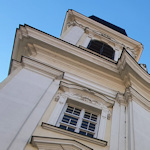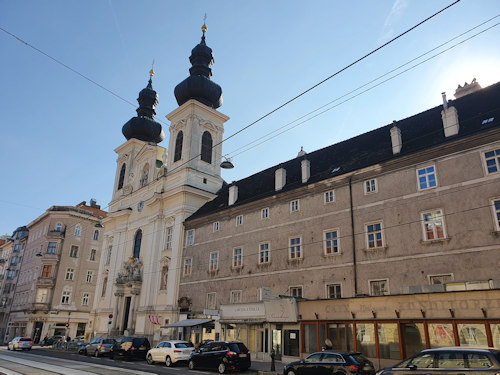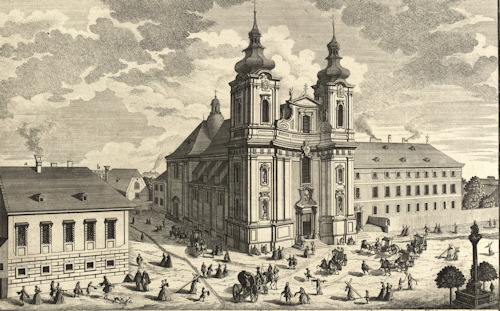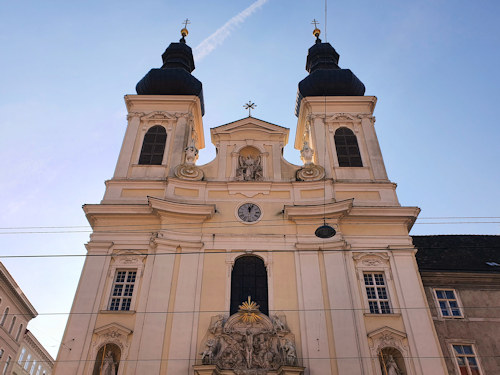
Just outside the old town centre of Vienna, the twin towers of the Alserkirche sit above two plaques that hint at a special musical connection for this early Baroque church.
- Built at the turn of the 17th and 18th centuries
- Hosted Beethoven’s funeral service
- Schubert wrote music for the church, too
- Book a classical concert experience* for Vienna
- See also:
- Other churches in the city
Church of the Holy Trinity

(Located on Alser Straße, which leads down directly to the old town)
The Alserkirche is the Church of the Holy Trinity, which serves the local parish and is run by the catholic Order of Friars Minor Conventual (OFM Conv). Construction of this early Baroque church began in 1694 and ended ten years later in 1704.
Back then, the church stood outside the city itself in the suburban municipality known as Alservorstadt, which is now split between the city’s eighth (Josefstadt) and ninth districts (Alsergrund).
The Trinitarian order built the church but withdrew in 1783 when religious reforms enacted by Emperor Joseph II saw the associated monastery dissolved (one of dozens of monasteries that fell victim to Joseph’s reformist zeal).
The OFM Conv moved in the following year, having been booted from their own location in Vienna.
(The Trinitarians later returned to the city and now manage the church on Mexikoplatz square in Vienna’s second district.)
As you might expect, a religious building of this age has a fair few historical connections.

(The church, as drawn by Salomon Kleiner, engraved by Johann August Corvinus and published by Johann Andreas d. Ä. Pfeffel in 1724; Wien Museum Inv.-Nr. 105462; excerpt reproduced with permission under the terms of the CC0 licence)
A plaque inside the main entrance mentions, for example, that Napoleon quartered troops in the Alserkirche crypt in 1812. (I can’t help but feel they might have had trouble getting a decent night’s sleep.)
Beethoven and Schubert
This being Vienna, of course, the musical connections perhaps interest us most.
A report in the April 12th, 1827 edition of the Wiener Theater-Zeitung noted (my amateur translation and interpretation of the annoyingly-hard-to-read font):
The funeral of one of the most extraordinary men of our times took place on Thursday, March 29th. It was the famous composer, Ludwig van Beethoven, a true Alcides1 of music…and the lively participation of learned individuals from all parts of society held the promise of a large crowd to witness the journey.
At 3pm, the funeral cortege collected both in and outside the apartment of the deceased in the Schwarzspanierhaus in the Alservorstadt, and the procession left at 3.15pm.
The artistic elite of the imperial city carried and surrounded the coffin…some 15,000 people from all parts of society accompanied the remains of this genius of a composer on his last journey.
Apparently, the crowd was such that the trip from the apartment to the church took an entire hour, rather than the usual few minutes.

(Beethoven’s funeral took place within)
That church was, of course, the Alserkirche. A plaque outside says (again, my translation):
Ludwig van Beethoven. The body of this immortal was blessed here on March 29th, 1827
Wiener Schubertbund 1927
After the service, the cortege moved on to a cemetery in Währing for the burial.
One of the “artistic elite” mentioned as attending Beethoven’s funeral service was Franz Schubert. His Mass No.6 premiered in the Alserkirche on October 4th, 1829.
The Wiener Schubertbund (Vienna Schubert Society) erected a second plaque commemorating Schubert’s connection to the church through another composition. My translation again:
Franz Schubert wrote the song, Faith, Hope and Love (Glaube, Hoffnung und Liebe) in September 1828, just weeks before his death, for the bell christening of this church
Wiener Schubertbund 1928
The lyrics to the song come from Christoph Kuffner’s poem of the same name, published in 1815. And just to close the circle…Kuffner might have provided the text for Beethoven’s 1808 Choral Fantasy.

(The Beethoven plaque)
How to get to the Alserkirche
The Langegasse tram stop is on the main road outside the church, served by the 5, 33, 43, and 44 trams. The latter two lines both leave from the central Schottentor station (on the U2 subway line). The 5 tram leaves from Westbahnhof station (U3 and U6 subway lines plus a major railway hub serving the west of Austria).
Opposite the church is the former general hospital (the first medical facilities on the site went up around the same time as the Alserkirche). You find university buildings there now, but the main courtyard has a couple of decent restaurants and a popular Christmas market.
Address: Alser Straße 17, 1080 Vienna
1Another name for Hercules